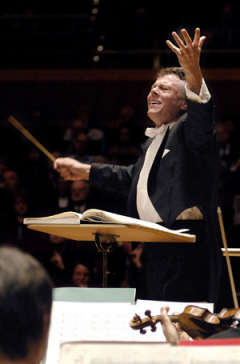Bavarian Radio SO in New York (I):
Karita
Mattila, Soprano, Bavarian Radio Symphony Orchestra, Mariss Jansons,
Chief Conductor,
Carnegie
Hall, New York City, 03.11.2006 (BH)
Shostakovich:
Symphony No. 6 in B Minor, Op. 54 (1939)
R.
Strauss:
Four Last Songs (1948)
R.
Strauss:
Der Rosenkavalier Suite (arr. 1944)

It’s
a great month when one can hear not one, but two readings
of Shostakovich’s underplayed Sixth Symphony. (Valery
Gergiev and the Kirov brought it here last week, in a
concert that was one of the high points of his Shostakovich
series.) Structurally slightly unusual, the Sixth
begins mournfully slow, followed by a peppier second movement
that is half the length of the first, and a raucous gallop
to end it all. In effect, the piece gets faster and faster
as it progresses. Mariss Jansons has recorded an
entire cycle of these symphonies with eight different
orchestras, which illustrates his versatility and consistency,
no matter what the ensemble, but this reading immediately
telegraphed that his three-night stay with the Bavarian
Radio Symphony Orchestra would be a weekend to remember.
If
one imagines the Fifth Symphony’s triumphant final bars,
the anguish that begins the Sixth seems particularly haunting,
its heated opening cry the perfect vehicle for the Bavarian
strings. Eventually the ensemble reaches a stirring,
passionate climax before the tension wanes, as waves of
soft trills fade into the eerie ending. The second
movement, a waltz that vacillates between slippery woodwinds
and craggy string writing, staggers about before again
finding a delicate conclusion, here showing off the ensemble’s
expert wind section. Shostakovich lets out all the
stops in the final movement, which explodes into a jaunty
comic circus that Jansons exploited for every last bit
of humor and virtuosity.
As
one reviewer noted, Karita Mattila looked great if not
exactly “autumnal” in a dramatic shoulder-less dark purple
dress, her hair a perfect coif atop her imposing frame.
One of the world’s current great interpreters of Richard
Strauss, she has recorded the Four Last Songs with
Claudio Abbado and the Berlin Philharmonic. Here,
her approach was more life-affirming, more soaring and
more athletic than the pure radiance used by some other
singers, as if this farewell is teeming with questions
and conundrums. I enjoyed her work on this evening,
as I usually do, but I’m not totally convinced she is
entirely at home in these masterpieces. It may seem
an odd comment, but their calm resignation almost seems
to stifle her natural dramatic instincts, ever so slightly,
which served her so well in her peerless Salome.
Robert
Frost’s little cat feet came to mind during the initial
encore, Johann Strauss’ Pizzicato Polka, and almost
hilarious in its quietude. It left a delicious aftertaste,
but I was hoping that Jansons and these expert players
would pull out all the stops for a second one, something
loud, and sure enough, during the applause additional
brass players sneaked onto the stage for a jet-propelled
“Farandole” from Bizet’s
L’Arlésienne.
Bruce Hodges
Picture
© Markus Dlouhy



